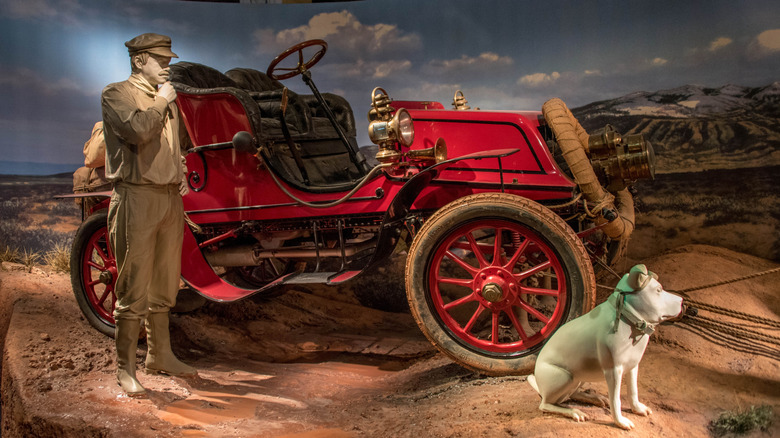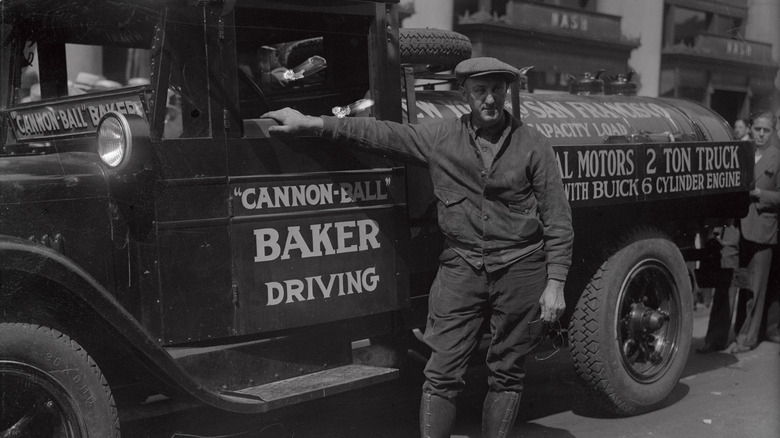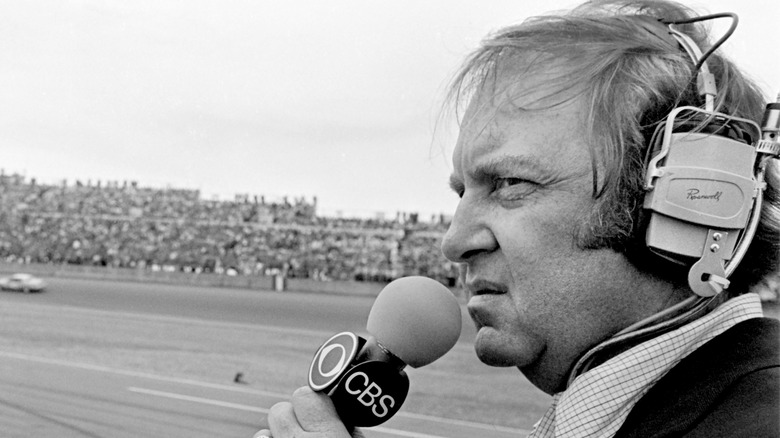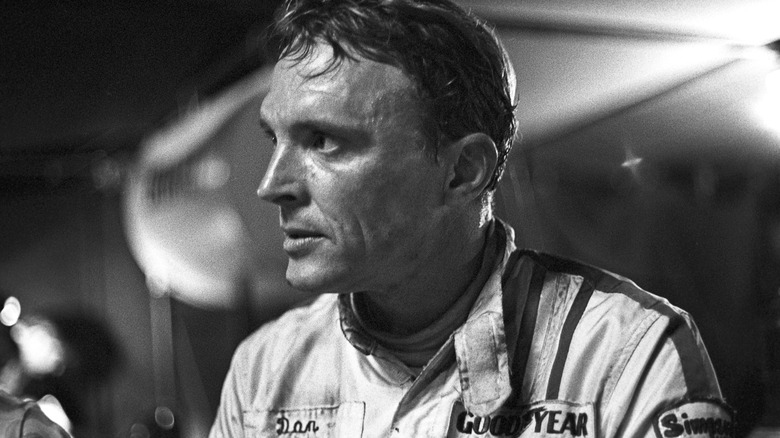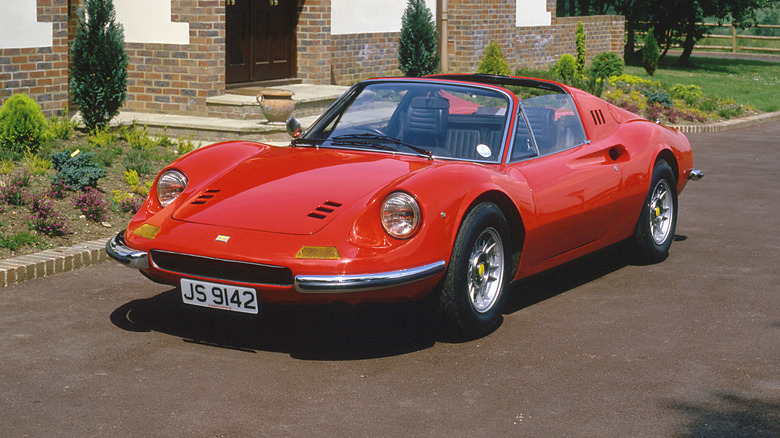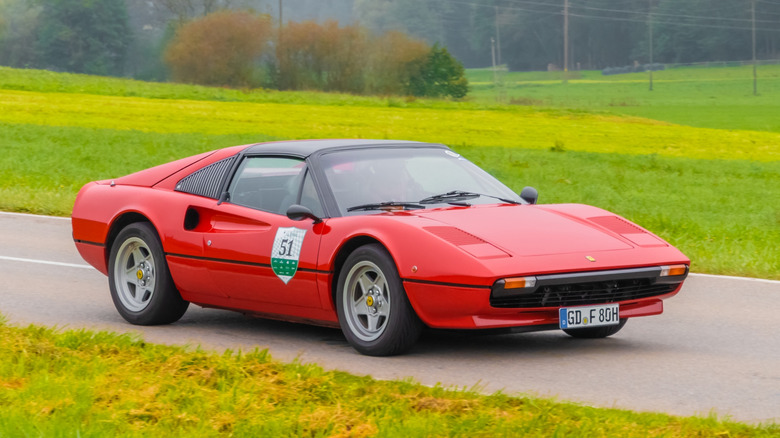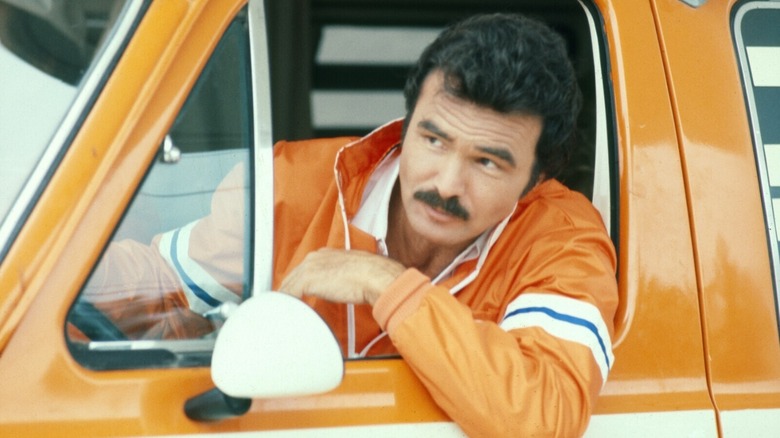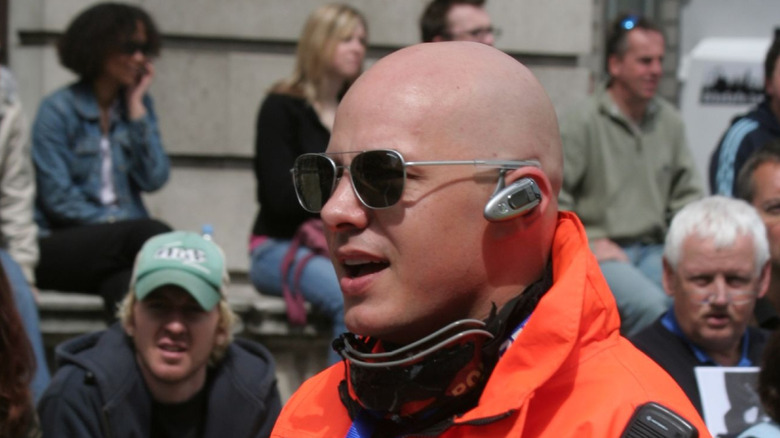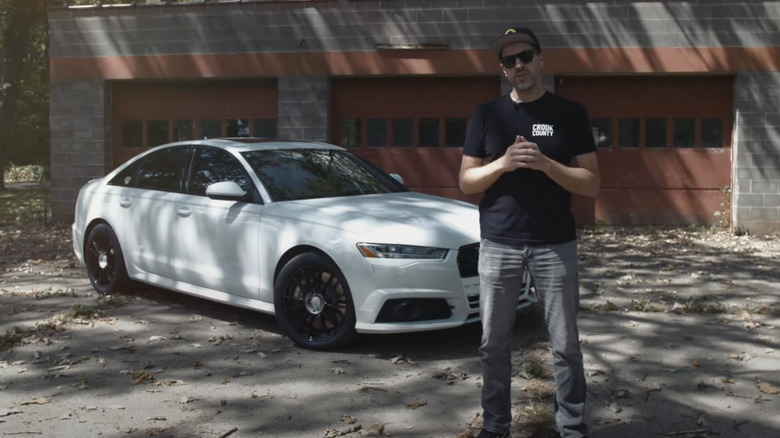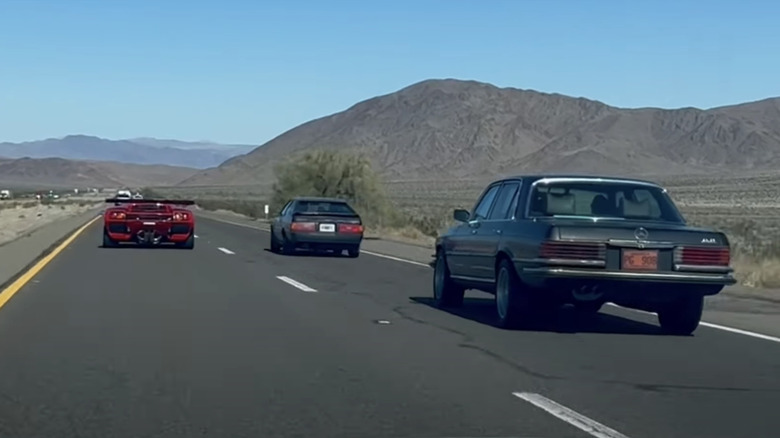The Forbidden High-Speed Race Across America
We may receive a commission on purchases made from links.
When people think about "forbidden" or "illegal" car races, what may come to mind are underground street racing events depicted in the "Fast and Furious" movies (well, mostly the earlier ones) and in other films and TV shows through the years. These events usually comprise a series of quick drag races with souped-up vehicles driven by rich and/or seedy individuals with money to burn. But there's another type of forbidden car race that has also been featured heavily on film, and in case you weren't around to watch those movies when they were in theaters (or simply haven't heard of them yet), this race is best known as the Cannonball Run.
The general premise of the Cannonball Run is simple — try to get your car from New York to California as quickly as possible. Early versions of this challenge saw drivers take their vehicles on the opposite route, but in any case, these runs were true tests of speed and vehicular endurance, to say little of the physical stress that drivers, navigators, and other team members had to go through. There's also the threat of police involvement; since Cannonball Run competitors frequently exceed speed limits, cops are often a few steps away with their badges and radar guns.
Purists may argue that the only real Cannonball Runs took place in the 1970s. But the idea of setting speed records for coast-to-coast driving dates much further back to the early 20th century, not too long after the time when cars were invented.
The first proto-Cannonball Run took over two months to complete
The origins of the Cannonball Run date back to the very early 1900s, and it all started with a bet made by Vermont doctor Horatio Nelson Jackson, who, in 1903, wagered $50 (or about $1,835 in today's money) that he could drive an automobile from San Francisco to New York in 90 days. This was during a time when cars were a fairly recent innovation, and a luxury that only the upper crust of society could afford. As such, it was hard to tell what these vehicles were truly capable of in those early days.
Assisted by bicycle racer and mechanic Sewall Crocker, Jackson drove off from San Francisco on May 23, 1903, on a used Winton touring car. Both men would later add a canine companion named Bud during a stopover in Idaho. With limited tools at their disposal and few paved roads to travel on, it wasn't an easy trip; they suffered multiple setbacks, either due to mechanical issues (blown tires, running out of fuel) or incorrect directions from townspeople. One such setback forced them to contact Winton itself for replacement parts, which led to a couple of other carmakers hearing about the challenge and sending out teams to attempt the transcontinental drive.
Jackson and Crocker finally reached their destination on July 26 — a good 63 days after the trip started, but well within the 90-day window that Jackson proposed.
Erwin 'Cannonball' Baker: The Cannonball Run's eventual namesake
Horatio Nelson Jackson's historic first-ever cross-country car trip was not known as a "Cannonball Run," and the man who later inspired the name was originally known as plain old Erwin George Baker, an acrobatic performer from Indiana who later took his act to vaudeville shows in San Francisco. After returning to his home state, Baker became a successful motorcycle racer, and that was his gateway into the world of coast-to-coast driving. In May 1914, he drove his Indian motorcycle from San Diego to New York City in 11 days, 12 hours, and 10 minutes; later that year, a New York journalist gave him the nickname "Cannonball," a moniker he would continue to use throughout his career.
As the years passed, Baker would make several more attempts at transcontinental drives, doing so on both motorcycles and automobiles. In 1915, it took him 11 days, 7 hours, and 15 minutes to go from coast to coast in his Stutz Bearcat, and he would keep breaking official records until November 1929, when he needed just 69 hours and 31 minutes while driving an air-cooled Series 14 Franklin. (Baker took 53 hours and 30 minutes in his final cross-country run in 1933, but this isn't considered official as it wasn't a scheduled record attempt.)
Baker died at the age of 78 in 1960, and it wouldn't be another decade before he reentered the pop culture zeitgeist, thanks to the efforts of two intrepid automotive journalists.
The birth of the actual Cannonball Run
The Cannonball Run, as we know it, originated in the early 1970s and was conceived by a pair of automotive magazine editors — Brock Yates (pictured above in 1981) and Steve Smith from Car and Driver. The event's official name — the Cannonball Baker Sea-To-Shining-Sea Memorial Trophy Dash — was clearly a tribute to Erwin Baker and his coast-to-coast records. But unlike Baker's trips from California to New York and vice versa, there was much more of an outlaw spirit in Yates and Smith's Cannonball Run: this was their way of sticking it to U.S. government-mandated car regulations.
"A balls-out, shoot-the-moon, f-the-establishment rumble from New York to Los Angeles to prove what we had been harping about for years—that good drivers in good automobiles could employ the American Interstate system the same way the Germans were using their Autobahns? Yes, make high-speed travel by car a reality! Truth and justice affirmed by an overtly illegal act," Yates proclaimed (via Hot Rod), summing up the event's vision and mission.
There was only one vehicle in the event — a 1971 Dodge Custom Sportsman van nicknamed "Moon Trash II" — and one team, which included the two Car and Driver editors, artist and writer Jim Williams, and Yates' 14-year-old son Brock Jr., the latter of whom served as a lookout in case the police got involved. The trip, which started at Manhattan's Red Ball Garage and ended at the Portofino Inn in Redondo Beach, California, took 40 hours and 51 minutes to complete. Due to mechanical issues and some rough driving conditions, the trip wasn't as fast as the group had expected, but it was still considerably faster than Baker's pre-World War II records by a great margin.
The second Cannonball Run involved a true U.S. racing legend
The second Cannonball Run was held about half a year after the first one, on November 15, 1971, and in this sophomore iteration there were eight teams, eight vehicles, and a total of 23 participants. By far the most prominent participant was Dan Gurney, who was arguably the era's most prominent auto-racing American. Unlike most other drivers who specialized in only one type of competition, Gurney achieved success in Formula One, the 24 Hours of Le Mans (which once saw one of the deadliest car crashes in history), the Indianapolis 500, and NASCAR, and he teamed up with none other than Brock Yates himself, the co-creator of the Cannonball Run, for the second edition.
Much like the inaugural Cannonball Run, the second running also started from the Red Ball Garage, and in what should come as no surprise, Gurney and Yates came in at first place, requiring 35 hours and 54 minutes to drive their 1971 Ferrari Daytona 365 GTB/4 from New York to California. Despite some weather-related delays, the duo shattered the previous record by almost five full hours, as did the next four teams that arrived at Redondo Beach within the next two hours or so.
The success of both 1971 Cannonball Runs led to further sequels in the coming years, and not even a nationwide speed limit could stop the records at these events from being broken.
Yates organized three more Cannonball Runs in the 1970s
With the two Cannonball Runs from 1971 garnering a lot of press, it wasn't too shocking that the third edition, which was won on November 13, 1972, had a whopping 34 entries. The Cadillac Coupe De Ville operated by winners Steve Behr, Bill Canfield, and Fred Olds fell over an hour short of Brock Yates and Dan Gurney's record, crossing the finish line in 37 hours and 16 minutes.
The fourth Cannonball Run took place well over two years later, on April 23, 1975. By that time, the U.S. had been under a restrictive speed limit of 55 mph for about a year, which was panned in the automotive media and was widely unpopular. However, that wasn't a problem for Rick Cline and Jack May, whose white Ferrari Dino 246 GTS (red version shown above) bested 17 other cars and narrowly broke the record by finishing in 35 hours and 54 minutes.
Cannonball Run aficionados had to wait till April 1, 1979, for the fifth race, which had an all-time high of 46 cars competing. The duo of Dave Heinz and Dave Yarborough shattered the previous record more convincingly, with their Jaguar XJS credited with a time of 32 hours and 51 minutes and an average speed of 86 mph. That was it for the Cannonball Run, though, and Yates told The New York Times that he stopped organizing the event "because I knew sooner or later that somebody was going to get killed."
The U.S. Express: A Cannonball Run-style race by another name
Brock Yates' Cannonball Run may have ended in 1979 due to safety concerns, but the U.S. Express came along at the start of the '80s with a similar premise. These events, however, were much lower-profile and had slightly different routes, with the first one starting in Brooklyn and ending in Santa Monica. The winners of that race were Rick Doherty and Will Wright, and if that latter name sounds familiar, that's because he later became known for beloved video game franchises such as "SimCity" and "The Sims." The duo fell just short of breaking the record, though, as they finished the race in 33 hours and 9 minutes.
Data on the 1981 U.S. Express is scant, but we do know that this race ran from Long Island to Emeryville and was won by David Morse and Steve Clausman. Even less is known about the 1982 iteration, since there is no documentation on who won, what car they drove, or how long it took them to go from coast to coast. In an interview, Morse, who also took part in the 1982 race, recalled that the event was a complete mess, with heightened scrutiny from law enforcement. "Everything that could go wrong did go wrong," he said in an interview. "The highway patrol of various states had been notified not only about the race but about our car specifically. The officer would know me by name."
The last U.S. Express took place in 1983, and was won by Doug Turner and David Diem, whose 1980 Ferrari 308 GTS (pictured above) smashed the record by finishing in 32 hours and 7 minutes.
The Cannonball Run in the movies
Most casual racing fans probably know the Cannonball Run via the multiple films based on the real-life coast-to-coast races. The best-known of these movies is 1981's "The Cannonball Run," with Brock Yates himself writing the script and an all-star cast led by Burt Reynolds, Roger Moore, Farrah Fawcett, and Rat Pack members Sammy Davis Jr. and Dean Martin. Despite boasting all that star power, neither the original film nor its 1983 sequel, which brought back much of the main cast, did well with critics, and the former scores an abysmal 29% on Rotten Tomatoes, while the latter does even worse at 12%. Roger Ebert was one of the many critics who savaged "The Cannonball Run," describing the film as "an abdication of artistic responsibility at the lowest possible level of ambition." In layman's terms, the movie was lazy and unfunny.
Then you've also got "The Gumball Rally" and "Cannonball," which both premiered five years before "The Cannonball Run" and also sought to combine fast-paced action and laughter in a film celebrating anti-speed limit outlaw racers. "The Gumball Rally" didn't do particularly well with critics, and "Cannonball" is so obscure that it doesn't even have a Rotten Tomatoes critic rating. It does, however, have a viewer rating of 34%, making it the film you want to avoid if you're thinking of going on a Cannonball Run-themed movie marathon.
Alex Roy broke the decades-old cross-country record in 2006
After the U.S. Express wrapped up without fanfare, the Cannonball Run and its spiritual successors, as well as the (mostly bad) movies it inspired, faded from relevance to remain a relic of '70s automotive culture, much like the 55-mph speed limit and the 1973 oil crisis that caused numerous restrictions like it. It wasn't until 2007 that cross-country driving records became a thing again, and this was thanks to the revelations disclosed in Alexander Roy's memoir, "The Driver: My Dangerous Pursuit of Speed and Truth in the Outlaw Racing World."
At the time the book was released, Roy was the head of a New York-based car rental agency and a veteran of several low-profile Cannonball Run-style events. Along with co-driver David Maher, Roy drove his heavily modified 2000 BMW M5 from New York to Los Angeles in 31 hours and 4 minutes in October 2006, expertly evading the cops multiple times along the way. That was more than enough to break the then-23-year-old record set at the 1983 U.S. Express, though the man behind the Cannonball Run didn't consider these runs as record-breaking. Speaking to The New York Times, Brock Yates said he has no problem with others attempting the transcontinental drive, but opined that they'd have to follow the original Cannonball Run route for records to be considered.
The present-day overall record (and other notable 21st-century NY-to-LA drives)
Alexander Roy's 2006 New York-to-LA driving record was a pivotal event, and the Cannonball record fell multiple times in the decade-and-a-half that followed. In 2013, the team of Ed Bolian, Dave Black, and Dan Huang became the first to break the 30-hour mark, registering a time of 28 hours and 50 minutes in their 2004 Mercedes-Benz CL55 AMG. Six years later, another three-man team, this time featuring Arne Toman (pictured above), Doug Tabbutt, and Berkeley Chadwick, obliterated that record by taking another Mercedes — an E63 AMG — from New York to Los Angeles in 27 hours and 25 minutes.
With COVID-19 forcing people to stay home and most businesses to shut their doors, a number of drivers took advantage of the situation and set new records, though some have argued that they shouldn't be considered due to the extraordinary conditions brought about by the historic global pandemic. Using the original Red Ball Garage to Portofino Inn route, Chris Allen, James Allen, and Kale Odhner finished the run in 26 hours and 38 minutes in their 2019 Audi A8 on April 9, 2020.
That record was extremely short-lived, though, as the duo of Toman and Tabbutt set what is the current overall record at the time of writing. In May 2020, Toman and Tabbutt took that same classic Cannonball Run route in their 2016 Audi S6 and finished the challenge in 25 hours and 39 minutes, with an average speed of 112 mph. Much like many other cars that broke the Cannonball record, the Audi had its share of aftermarket modifications, notably including a decoy badge to make the vehicle vaguely resemble a Ford Police Interceptor if viewed from a distance.
The revived U.S. Express and the new competitive record
When talking about Arne Toman and Doug Tabbutt's May 2020 Cannonball Run overall record, the operative word is "overall," since unlike the Cannonball Runs of old, no other drivers or teams were competing against them. That too can be said about the other 21st-century records, but when it comes to actual Cannonball Run-style races with multiple competitors, that record has also been broken, and it happened during the revived U.S. Express, which returned on October 27, 2023, a full four decades after its last iteration.
Keeping in the spirit of the OG U.S. Express, the new version only allowed 1983 or older vehicles and engines, and all 15 entries were personally selected by the event's organizer, Taylor Hull. This time, however, the new U.S. Express was more faithful to the classic Cannonball Run route, unlike the previous ones, where the start and end points were far more fluid. What was fluid, however, was the start time for each of the teams, which could take place anywhere between 6 p.m. and midnight. That's likely how organizer Hull and his team managed to hold the new competitive record of 31 hours and 36 minutes for just one hour; not long after they arrived at the Portofino Inn, the record was broken by Cameron Davis and Aaron Tulin's 1979 Mercedes-Benz 450 SEL 6.9, which took 30 hours and 56 minutes to get from the Red Ball Garage to the Portofino.
Will we see the non-competitive record go below the 24-hour barrier, or will we see times under 30 hours for competitive Cannonball Run-inspired events? Time will tell, but one thing's for certain — there's no shortage of modern-day drivers willing to put their vehicles to the test in these challenges.

